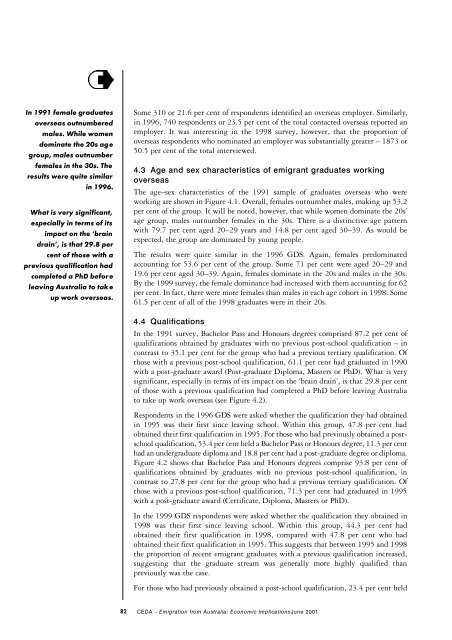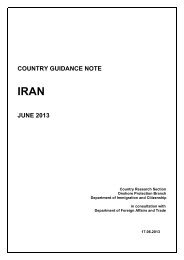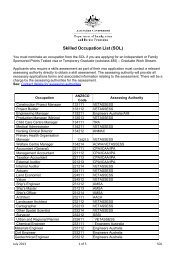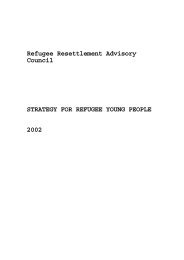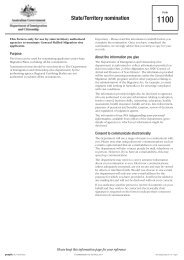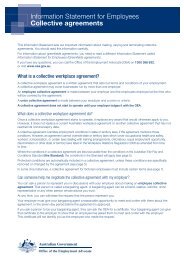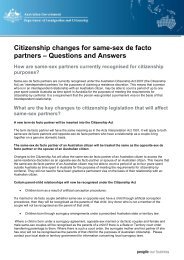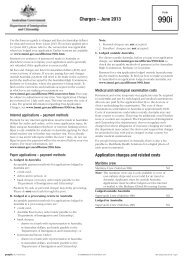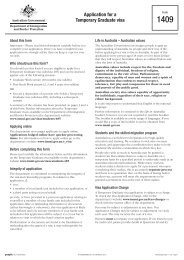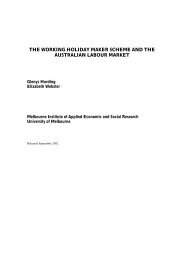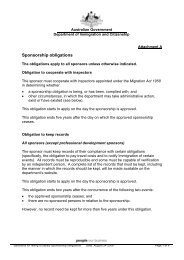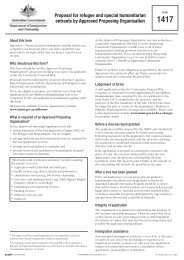part three - Department of Immigration & Citizenship
part three - Department of Immigration & Citizenship
part three - Department of Immigration & Citizenship
Create successful ePaper yourself
Turn your PDF publications into a flip-book with our unique Google optimized e-Paper software.
In 1991 female graduates<br />
overseas outnumbered<br />
males. While women<br />
dominate the 20s age<br />
group, males outnumber<br />
females in the 30s. The<br />
results were quite similar<br />
in 1996.<br />
What is very significant,<br />
especially in terms <strong>of</strong> its<br />
impact on the ‘brain<br />
drain’, is that 29.8 per<br />
cent <strong>of</strong> those with a<br />
previous qualification had<br />
completed a PhD before<br />
leaving Australia to take<br />
up work overseas.<br />
Some 310 or 21.6 per cent <strong>of</strong> respondents identified an overseas employer. Similarly,<br />
in 1996, 740 respondents or 23.5 per cent <strong>of</strong> the total contacted overseas reported an<br />
employer. It was interesting in the 1998 survey, however, that the proportion <strong>of</strong><br />
overseas respondents who nominated an employer was substantially greater – 1873 or<br />
50.5 per cent <strong>of</strong> the total interviewed.<br />
4 . 3 Age and sex characteristics <strong>of</strong> emigrant graduates working<br />
o v e r s e a s<br />
The age–sex characteristics <strong>of</strong> the 1991 sample <strong>of</strong> graduates overseas who were<br />
working are shown in Figure 4.1. Overall, females outnumber males, making up 53.2<br />
per cent <strong>of</strong> the group. It will be noted, however, that while women dominate the 20s’<br />
age group, males outnumber females in the 30s. There is a distinctive age pattern<br />
with 79.7 per cent aged 20–29 years and 14.8 per cent aged 30–39. As would be<br />
expected, the group are dominated by young people.<br />
The results were quite similar in the 1996 GDS. Again, females predominated<br />
accounting for 53.6 per cent <strong>of</strong> the group. Some 71 per cent were aged 20–29 and<br />
19.6 per cent aged 30–39. Again, females dominate in the 20s and males in the 30s.<br />
By the 1999 survey, the female dominance had increased with them accounting for 62<br />
per cent. In fact, there were more females than males in each age cohort in 1998. Some<br />
61.5 per cent <strong>of</strong> all <strong>of</strong> the 1998 graduates were in their 20s.<br />
4 . 4 Q u a l i f i c a t i o n s<br />
In the 1991 survey, Bachelor Pass and Honours degrees comprised 87.2 per cent <strong>of</strong><br />
qualifications obtained by graduates with no previous post-school qualification – in<br />
contrast to 35.1 per cent for the group who had a previous tertiary qualification. Of<br />
those with a previous post-school qualification, 61.1 per cent had graduated in 1990<br />
with a post-graduate award (Post-graduate Diploma, Masters or PhD). What is very<br />
significant, especially in terms <strong>of</strong> its impact on the ‘brain drain’, is that 29.8 per cent<br />
<strong>of</strong> those with a previous qualification had completed a PhD before leaving Australia<br />
to take up work overseas (see Figure 4.2).<br />
Respondents in the 1996 GDS were asked whether the qualification they had obtained<br />
in 1995 was their first since leaving school. Within this group, 47.8 per cent had<br />
obtained their first qualification in 1995. For those who had previously obtained a postschool<br />
qualification, 53.4 per cent held a Bachelor Pass or Honours degree, 11.3 per cent<br />
had an undergraduate diploma and 18.8 per cent had a post-graduate degree or diploma.<br />
F i g u re 4.2 shows that Bachelor Pass and Honours degrees comprise 93.8 per cent <strong>of</strong><br />
qualifications obtained by graduates with no previous post-school qualification, in<br />
contrast to 27.8 per cent for the group who had a previous tert i a ry qualification. Of<br />
those with a previous post-school qualification, 71.3 per cent had graduated in 1995<br />
with a post-graduate award (Certificate, Diploma, Masters or PhD).<br />
In the 1999 GDS respondents were asked whether the qualification they obtained in<br />
1998 was their first since leaving school. Within this group, 44.3 per cent had<br />
obtained their first qualification in 1998, compared with 47.8 per cent who had<br />
obtained their first qualification in 1995. This suggests that between 1995 and 1998<br />
the proportion <strong>of</strong> recent emigrant graduates with a previous qualification increased,<br />
suggesting that the graduate stream was generally more highly qualified than<br />
previously was the case.<br />
For those who had previously obtained a post-school qualification, 23.4 per cent held<br />
82 C E DA – Emigration from Australia: Economic ImplicationsJune 2001


